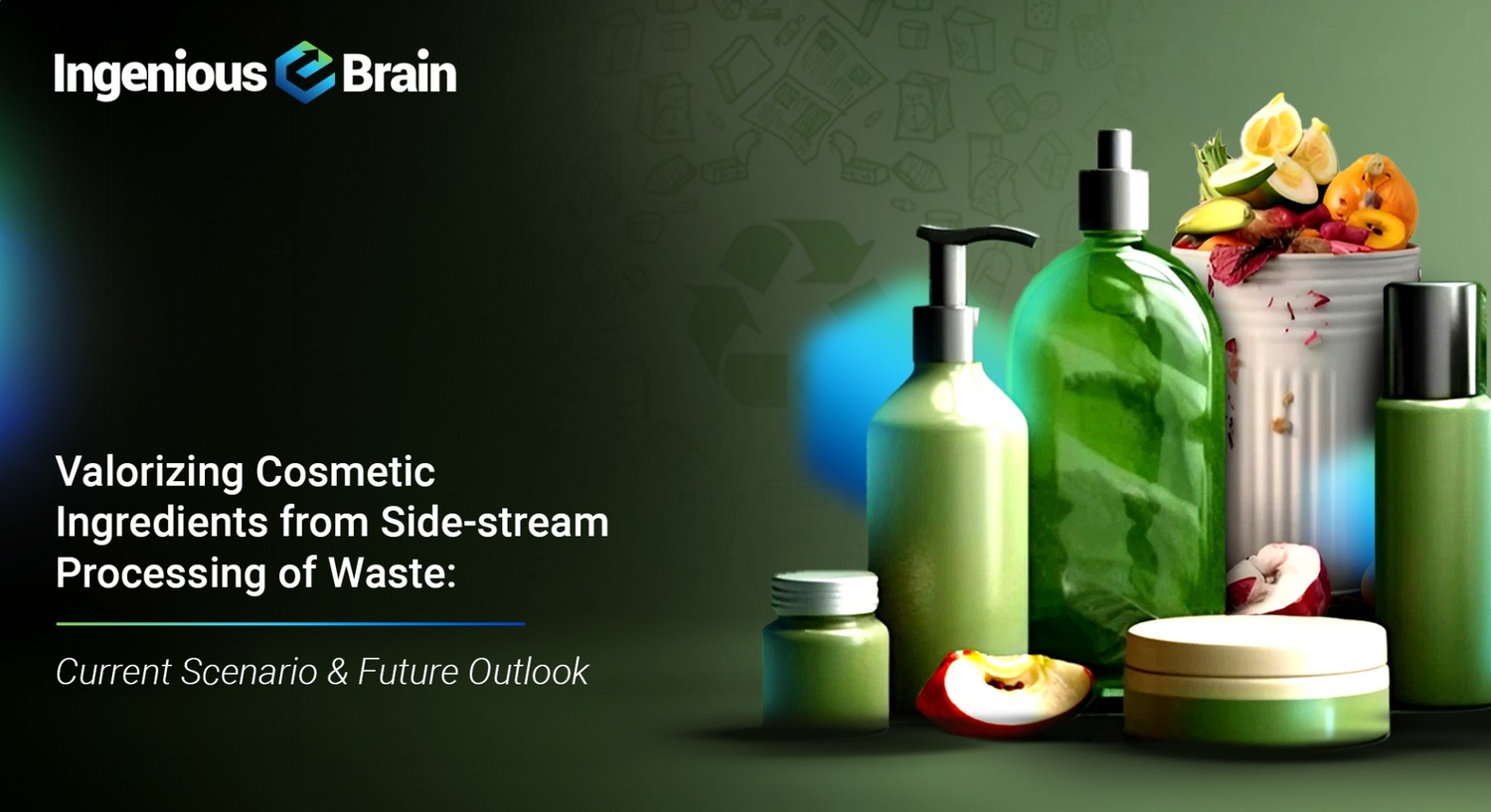Sustainable Cosmetic Ingredients from Waste: A Crucial Approach
Overview
According to Ingenious e-Brain, the cosmetic sector is amongst the most rapidly expanding industries globally and is projected to grow steadily at a compound annual growth rate (CAGR) of 5.84% between 2023 and 2030. This growth rate is supported by the consumer inclination toward products made up of organic, green, or sustainable ingredients. One of the ways through which this market can be further propelled is by upscaling side-stream processed ingredients. In today’s global context, the problem of wastage appears as a significant issue demanding attention and resolution. As per the data published by The World Counts, about 1.3 billion tons of food is wasted annually. It is undeniable that food loss occurs at various stages throughout the entire lifecycle of food processing, from harvesting to end-user consumption. The residual food materials, even after processing, keep many bioactive compounds, including proteins, lipids, fiber, essential oils, carbohydrates, and phytochemicals, such as polyphenols and carotenoids. Utilizing these waste materials to develop products of high commercial value is termed side-stream processing. This revolutionary upscaling offers a solution for repurposing food that humans would otherwise not consume. This process involves extracting high-quality upcycled ingredients that retain their natural functionality and contribute positively to the environment.
What are the Advantages of Valorizing Cosmetic Ingredients from Waste?
Utilizing side-stream processed ingredients has major benefits to both consumers and producers. From the producer’s point of view, side streams are typically more cost-effective to obtain than mainstream products since they primarily consist of waste byproducts. From the consumers’ perspective, the preference is towards purchasing items crafted from sustainable ingredients.
In addition, cosmetic products derived from waste side-streaming aim to:
- Reduce the environmental impact of waste disposal and greenhouse gas emissions
- Create new revenue streams and business opportunities for waste producers and cosmetic manufacturers
- Enhance the functionality and diversity of cosmetic products by adding novel and natural ingredients
What are the challenges associated with the side-streaming of cosmetic products from waste?
While the advantages of using side-stream products are substantial and unprecedented, the industry still faces challenges in scaling up operations. The main reason for that can be attributed to a lack of ability in efficient extraction of the desired product from the waste sources. Another barrier in the cosmetic industry is that extensive research and development are needed to extract a bioactive compound effectively from the waste product, which can be time-consuming and expensive. Also, side streaming brings a greater possibility of added environmental toxins such as mold, fungus, bacteria, etc., posing a substantial risk of contamination during handling and storage.
Current Scenario of the Evolving Sustainable Cosmetic Business Landscape
Side stream products can be obtained from a wide variety of waste food products such as grape skins, fruit seeds, fruit pits, used coffee beans, leftover juice pulp, etc. The range is wide, and the possibilities are endless.
A few sustainable cosmetic companies are working to transform side streams into mainstream products; for example, Lumene, owned by Verdane, is a cosmetics company developing products derived from side-streaming raw materials, including cloudberry, Finnish oats, and bilberry. Montinutra, a Finland-based start-up owned by Metsäliitto Cooperative, explores side stream possibilities by extracting high-value bioactive compounds from sawdust collected from sawmills that are otherwise incinerated in bio-power plants and further cause emission of greenhouse gases.
Future Outlook
Residues from various sectors can be integrated into the production chain of cosmetic products to elevate the latter’s value. Some of the examples to justify the point are:
- Whey from the dairy industry can be fermented to produce galacto-oligosaccharides (GOS) and lactobionic acid (LBA), two ingredients with moisturizing, anti-aging, and anti-inflammatory properties for the skin.
- Wheat and rye bran milling by-products from the agro-food industry can be used to produce prebiotic and antioxidant ingredients for the skin and hair.
- Papermill wastewater can be treated to produce polyhydroxyalkanoates (PHA), a biodegradable and biocompatible polymer to make eco-friendly packaging films for cosmetic products.
Conclusion
In conclusion, sustainability is the need of the hour in the cosmetic industry, especially considering the insufficient land available for cultivating crops to meet the needs of the expanding population, let alone for producing ingredients for cosmetics. Adapting the strategy of “best from waste” will not only save the planet but also allow us to leave something for future generations before it is too late.
If you’re uncertain about where to begin with side-stream processing, don’t worry! Ingenious e Brain is here to support you in starting your sustainability journey within the cosmetics industry. We are a leading advisory and management consulting firm offering expert advice and strategic insights on the technological and commercial landscape of diverse sectors, projecting trends and developments over the next one to ten years. We can support your company in understanding the ingredients that can be extracted from the waste of other industries, their business potential, opportunities for new product development with those ingredients, addressing the shifting trends of industry towards sustainable or green cosmetics, understanding the activities of your competitors, identifying suppliers for the waste valorized ingredients, and in many other ways. Reach out to our technology professionals and business experts by filling out the form below or emailing us at contact@iebrain.com.
According to Ingenious e-Brain expertise, there is growing interest in certifying upcycled cosmetic ingredients, which could lead to more widespread adoption of these sustainable practices. The future of waste-valorized ingredients for cosmetics involves increasing the use of upcycled and sustainable ingredients in cosmetic formulations. Overall, the trend is toward greater sustainability in the cosmetics industry, with a focus on reducing waste and promoting the use of upcycled and sustainable ingredients. For instance, Full Circle uses plant-based leftovers to make upcycled ingredients like Blueberry NECTA®, a natural active oil for blue light defense, and Blueberry CRUSH™ skincare and body care exfoliators. Other companies are developing products made entirely from by-products and leftovers, aiming to reduce the consumption of resources.


